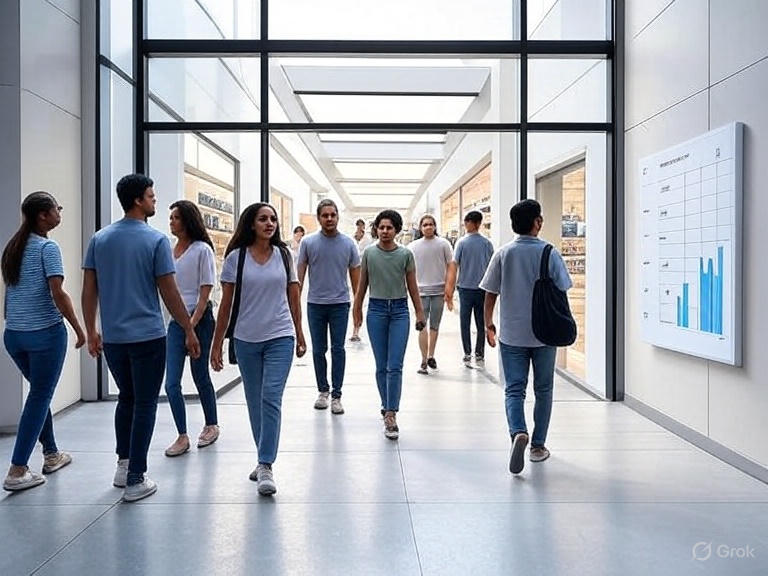As August 2025 unfolds, retailers are transitioning from summer sales to the anticipation of fall campaigns and early holiday planning. In this pivotal period, people counting technology is proving indispensable for adapting to consumer behaviors influenced by economic recovery and digital integration. With foot traffic patterns evolving due to hybrid work models and experiential shopping demands, people counting in retail provides the data backbone to optimize operations and drive revenue. By leveraging accurate visitor metrics, stores can align staffing, inventory, and marketing with real-time insights, ensuring they capitalize on every opportunity in a competitive landscape.
Industry Insights: Market Momentum and Emerging Trends in 2025
The people counting market is on a steep upward trajectory this year, reflecting the sector’s critical role in data-driven retail strategies. According to recent forecasts, the global people counting system market is estimated at USD 1.45 billion in 2025, projected to reach USD 2.67 billion by 2030, growing at a CAGR of approximately 13%. This expansion is largely fueled by retail applications, where the need for precise traffic analysis helps combat challenges like supply chain volatility and rising operational costs. Another analysis pegs the market at USD 1.39 billion in 2025, with a CAGR of 13.7% through 2030, highlighting consistent growth driven by technological innovations.
Key trends shaping people counting in retail include the fusion of sensors—such as thermal, video, and LiDAR—for enhanced accuracy in complex environments. AI integration is advancing rapidly, enabling predictive analytics that forecast traffic based on factors like local events or weather patterns. Sustainability is also a focal point, with systems optimizing energy use by adjusting lighting and HVAC according to occupancy levels. Moreover, privacy-compliant features, like anonymized data processing, are becoming standard to meet global regulations. These developments are particularly timely as retailers prepare for high-volume seasons, allowing them to refine strategies amid economic pressures and shifting consumer priorities.
Practical Applications: Innovative Ways People Counting Drives Retail Success
Beyond basic tallies, people counting technology in retail unlocks a suite of applications that enhance efficiency and customer engagement. One emerging use is AI-powered personalization, where systems analyze dwell times and paths to trigger tailored in-store experiences, such as AR displays for product recommendations in high-traffic aisles. This not only boosts conversion rates but also fosters loyalty in an era where shoppers crave seamless omnichannel interactions.
In terms of operational optimization, people counting facilitates dynamic staffing adjustments. For instance, during August’s back-to-school surge, real-time data can predict peak hours, ensuring adequate personnel to handle crowds and reduce abandonment rates. Integration with inventory management systems allows retailers to correlate traffic with stock levels, preventing shortages in popular categories like apparel or electronics.
Security and loss prevention benefit too, with anomaly detection alerting teams to unusual patterns, such as overcrowding in sensitive areas. For multi-location chains, aggregated data across stores reveals regional trends, informing targeted promotions or layout changes. In experiential retail spaces, like pop-up events, counters measure engagement metrics to evaluate ROI, guiding future investments. Overall, these applications contribute to cost savings—up to 20% in labor and energy—while elevating the shopping experience.
How TraxSales’ Solutions Deliver Tangible Benefits for Retailers
TraxSales stands out by offering people counting solutions that emphasize accountability and actionable intelligence, tailored specifically for retail environments. Their systems provide real-time foot traffic data with photo verification, ensuring every entry is accurately captured and tied to sales outcomes. This feature allows retailers to pinpoint which team members excel at conversions and where opportunities are being missed, often resulting in a 15% sales increase within just 60 days.
A core benefit is enhanced salesperson performance tracking, identifying underperformers and enabling data-driven coaching to improve close rates. Lead capture is streamlined, as the platform monitors unsold interactions and follow-ups, transforming potential losses into nurtured prospects. Retailers gain unprecedented visibility into post-entry customer journeys, eliminating guesswork on sales variances.
Testimonials underscore these advantages: A VP of Sales noted, “This is the first tool that’s ever held our team truly accountable. We’re no longer guessing why sales fluctuate—we have the answers.” Similarly, a Director of Store Operations highlighted a swift rise in close rates by tracking walk-in assistance. With over 1,000 retailers relying on TraxSales, the solutions prove scalable for businesses of all sizes, delivering quick ROI through precise metrics and user-friendly dashboards.
Looking Forward: Why People Counting is Essential for 2025 and Beyond
As we move deeper into 2025, people counting in retail will continue to evolve, incorporating advanced AI for even more predictive capabilities. Retailers who adopt these technologies now will build resilient operations, ready to thrive in uncertain times.
TraxSales is at the forefront, providing the tools to count every opportunity accurately. Discover how their solutions can elevate your retail strategy—visit TraxSales today and step into a data-empowered future.


